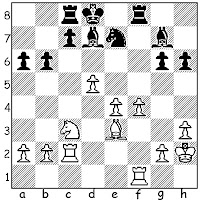The following game could just as easily be called "Buttons, buttons, who's got the buttons?" because White wins in the end simply because he has more buttons - er, pawns.
An interesting question of Jerome Gambit nomenclature comes up, however, hence the title of today's post (and the graphic of the counter-puncher).
Wall, Bill - Guest545050
PlayChess.com, 2013
1.e4 e5 2.Nf3 Nc6 3.Bc4 Bc5 4.Bxf7+
4...Kxf7 5.Nxe5+ Nxe5 6.Qh5+ Kf8 7.Qxe5 Bxf2+
Bill Wall suggests that this variation be called the Jerome Countergambit. I think that name is appropriate, as, in the Jerome Gambit, Black executes the same Bishop sacrifice that White played earlier. However, I would like to expand the name to the whole strategy of Black's counter-sacrifice.
Interestingly, in The Database I found only 8 other examples of 7...Bxf2+ as in the current game.
After a different defensive line, however, that of 6...g6 (instead of 6...Kf8) 7.Qxe5 Bxf2+, I found 84 examples.
While readers may not be surprised that after 6.d3 (instead of 6.Qh5+ as in the game) I found only 1 example of the countergambit 6...Bxf2+, it might be shocking to discover that in the "modern" Jerome Gambit line 5.d3 (instead of 5.Nxe5+) there are 842 examples of 5...Bxf2+.
Over the years there have been a number of comments about the ideas behind the Jerome Countergambit, from the thoughts of Brian Wall to today's game by Bill Wall. As for me, I've written a memo: More to explore!
8.Kxf2
8...Qf6+
The alternative, 8... Qh4+, in true Jerome Gambit style, showed up in perrypawnpusher - superlopez, blitz, FICS, 2010 (1-0, 71), which apparently, somehow, was never posted here. (I'll remedy that in a few days.)
9.Qxf6+ Nxf6
As I've mentioned elsewhere, recently, in a similar situation, "Black has an even game. However, given that he had a won game at move 4, this is not actually progress". Actually, things are worse in this particular case, as Black's exchange of Queens has left him a pawn down.
10.Nc3 g6
11.d4 d6 12.Bg5 Kg7
Moving too quickly. (For a recent, similar example, see "By the Numbers".)
As I've said before: as "bad" as the Jerome Gambit is, it still demands the defender's full attention.
13.Bxf6+ Kxf6 14.Nd5+ Kg7 15.Nxc7 Rb8 16.Nb5 Rf8+ 17.Ke2 Bg4+ 18.Ke3 Rbd8 19.Nxa7 Rde8
20.Nb5 d5 21.e5 Bf5 22.Nd6 Ra8 23. Nxf5+ Rxf5 24.g4 Rf7 25.h4 Raf8
26.Rh3 Rf4 27.g5 b5 28.a4 bxa4 29.Rxa4 Rf2 30.Ra7+ Kg8 31.Rc7 Black resigned
Black has nothing against the Queenside buttons.


















































